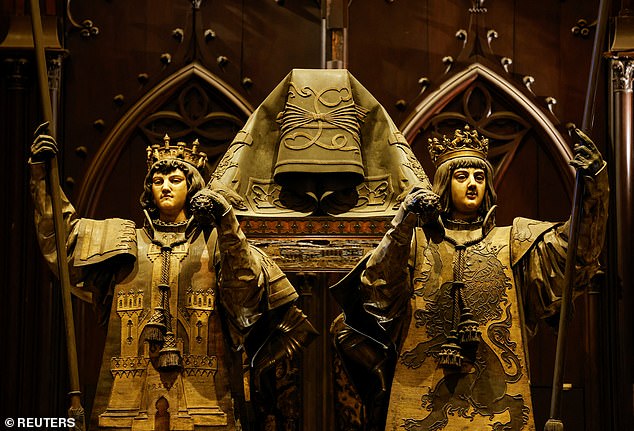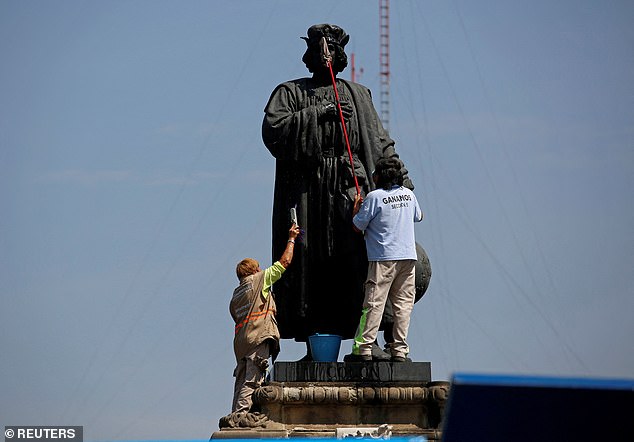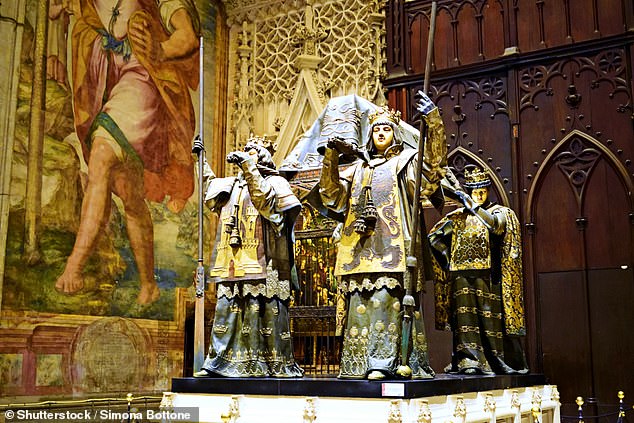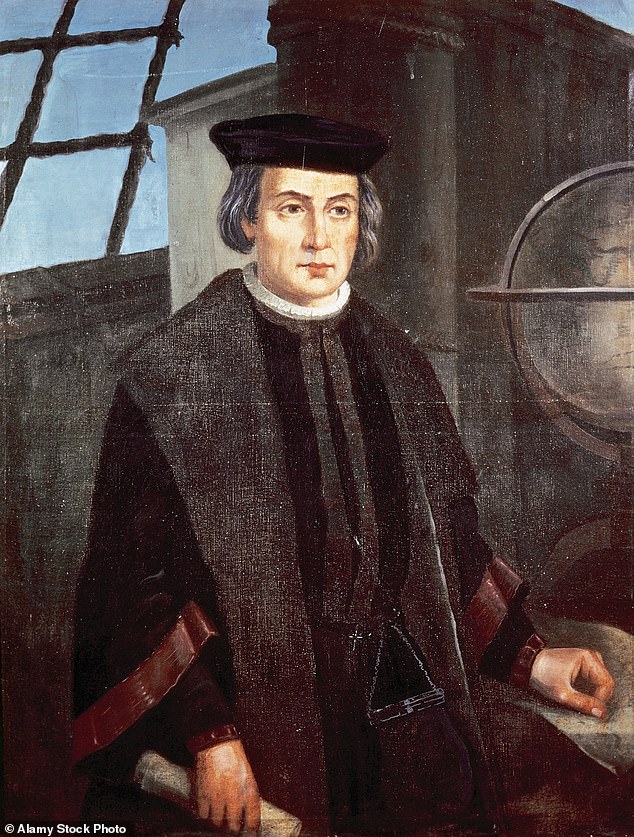Christopher Columbus was Jewish and from Western Europe, a study found after the discovery of his remains 500 years after his death.
Experts have long debated the origins and final resting place of the 15th-century explorer who led Spanish-funded expeditions from the 1490s onwards, paving the way for the European conquest of the Americas.
Many historians have questioned the traditional theory that Columbus came from Genoa, Italy. Other theories range from him being a Spanish or Greek Jew, to Basque, Portuguese or British.
To solve the mystery, investigators conducted a 22-year investigation, led by forensic expert Miguel Lorente, analyzing small samples of remains buried in Seville Cathedral, long considered by authorities there to be the last resting place. of Columbus, although there were rival claims that he was buried in the Dominican Republic.
They compared them with those of known relatives and descendants and their findings were announced in a documentary titled ‘Columbus DNA: The True Origin’ on Spanish national broadcaster TVE on Saturday.
Christopher Columbus was Jewish and from Western Europe, according to a study after the discovery of his remains 500 years after his death

A view of the mausoleum of Christopher Columbus in the cathedral of Seville, Spain October 11, 2024
‘We have DNA from Christopher Columbus, very partial, but sufficient. We have DNA from Hernando Colón, his son,’ Lorente said in the program.
‘And in both the Y chromosome (male) and in the mitochondrial DNA (transmitted by the mother) of Hernando there are traits compatible with Jewish origin.’
Around 300,000 Jews lived in Spain before the ‘Catholic Monarchs’, the Catholic kings Isabella and Ferdinand, ordered Jews and Muslims to convert to the Catholic faith or leave the country.
Many settled around the world. The word Sephardic comes from Sefarad, or Spain in Hebrew.
After analyzing 25 possible locations, Lorente said it was only possible to say that Columbus was born in Western Europe.
On Thursday, Lorente said they had confirmed previous theories that the remains in Seville Cathedral belonged to Columbus.
The investigation into Columbus’s nationality was complicated by a number of factors, including the large amount of data. But “the result is almost absolutely reliable,” said Lorente.
Columbus died in Valladolid, Spain, in 1506, but wanted to be buried on the island of Hispaniola, which today is shared by the Dominican Republic and Haiti.
His remains were brought there in 1542, then transferred to Cuba in 1795 and then, as long thought in Spain, to Seville in 1898.
Lorente stated last Thursday: ‘Today it has been possible to verify it with new technologies, so the previous partial theory that the remains of Seville belong to Christopher Columbus has been definitively confirmed.’
Many experts have believed that the tomb inside the cathedral has long housed the body of Columbus, but it was not until 2003 when Lorente and historian Marcial Castro obtained permission to open it, discovering that previously unknown bones were found inside.

Workers clean the statue of Italian explorer Christopher Columbus, also known as Christopher Columbus, surrounded by a metal fence during Columbus Day, or Dia de la Raza, in remembrance of when Columbus arrived in the Americas, in Mexico City . Mexico October 12, 2020
At that time, DNA technology was not capable of “reading” a small amount of genetic material to provide accurate results.
Columbus set sail on August 3, 1492 from the Spanish port of Palos, hoping to find a route to the legendary riches of Asia.
Along with three ships, the Niña, the Pinta, and the Santa María, Columbus and approximately 100 men embarked on the voyage that took them to the other side of the world… and far from their original destination.
On October 12, 1492, the ships made landfall in what are now the Bahamas, and later that month Columbus saw Cuba and thought it was mainland China.
And two months later, the ships landed in what Columbus thought might be Japan.
On the second voyage in 1493, Columbus intentionally sailed back to the New World and landed in Puerto Rico, where he enslaved many of the island’s native Taínos, some of whom were sent back to Spain.
Many Spaniards came over the next four years, resulting in the deaths of some seven million Taínos, 85 percent of the population.
The arrival of Europeans also caused the spread of deadly diseases such as smallpox and measles, and many historians claim that Columbus also brought the first syphilis-like diseases to the Americas.
But a study in January found the disease was proliferating thousands of years earlier.
The first appearance of a syphilis epidemic was documented in the late 15th century in Europe, leading historians to believe that it reached the Americas when Columbus set foot on the continent.
DNA evidence has now revealed that treponematosis, an ancient syphilis-like disease, existed in Brazil more than 2,000 years before the explorer set sail for the new world.

Researchers obtained permission to open a tomb located in a Spanish cathedral in 2003, and found bone fragments from an unknown human. Now, the team confirmed that the remains are Columbus’s.
Kerttu Majander, a postdoctoral researcher at the University of Basel, said: “The fact that the findings represent an endemic type of treponemal diseases and not sexually transmitted syphilis, leaves the origin of sexually transmitted syphilis still unresolved.”
The team examined the bones of four people who died in the coastal region of Santa Catarina, Brazil, thousands of years ago.
Pathogens were found in the remains that showed signs of a syphilis-like disease that likely caused mouth sores and shin pains.
The study, published in Nature, states that the bones were excavated at the Jabuticabeira II archaeological site and have been studied since 2016.
The researchers examined 37 of 99 sequencing data samples and found that there were between seven and 133 positive results for diseases derived from the Treponema family.
Verena Schünemann, co-author of the study, says: “Although the origin of syphilis still leaves room for the imagination, at least we now know without a doubt that treponematoses were not foreign to the American inhabitants who lived and died centuries before the continent. “. It was explored by Europeans.


